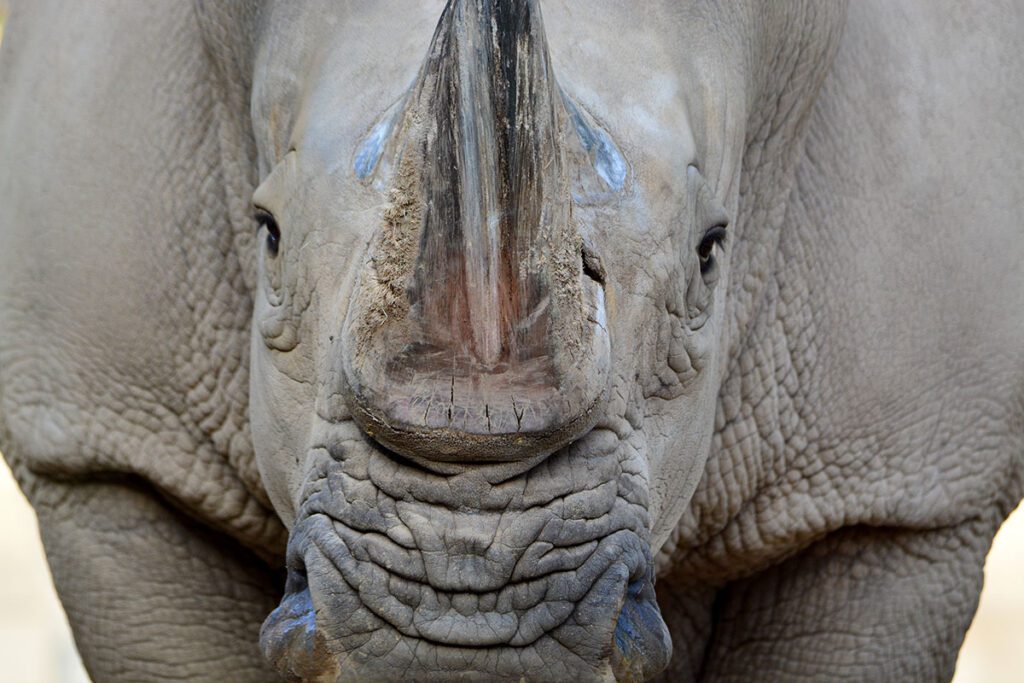May 3, 2018
If you have visited Seneca Park Zoo you have probably met Bill the southern white rhinoceros, an impressive megaherbivore who has stolen the hearts of guests and staff alike. It’s hard to look into the eyes of such an incredible animal and think about the brutal poaching crisis rhinos are facing in their natural range. But if you have met Bill, you have already contributed to saving his species.The southern white rhino conservation story is one of rare overwhelming success. While the historical range of these rhinos was at one time widespread across southern Africa, they were believed to be extinct in the late 19th century. However, in 1895 a population of less than 100 individuals was discovered in the Kwazulu-Natal region of South Africa. Conservationists worked hard to protect this small population, and they began efforts to rebuild the species. Then came Ian Player, a passionate conservationist who spearheaded Operation Rhino at the Hluhluwe-iMfolozi Park. During the 1950s and 1960s, Player and his team worked tirelessly on this project to translocate white rhinos from iMfolozi to restock other neighboring reserves including Kruger National Park, where the largest population of white rhinos currently live. Thanks to the determination of one conservationist, a project was started that saw the population of rhinos grow from less than 100, and on the brink of extinction, to a stable population of about 20,000 today.Southern white rhinos are listed by the IUCN as Near Threatened, making them the only species of rhino that are not listed as Endangered today. However, over the last five years, South Africa has seen a major spike in poaching levels, with over 1,000 white rhinos killed by poachers every year. Poachers are after the rhino for their most distinguishable trait – their horn. Rhino horn is made of keratin, which is falsely alleged to have medicinal purposes in many Asian cultures. One rhino horn can be worth hundreds of thousands of dollars, which drives poachers to risk their lives to acquire them. Conservationists are getting creative with new ways to prevent poaching, utilizing drones to patrol reserves, implanting GPS trackers into rhino horns, and even air lifting rhinos from helicopters to relocate them to safer areas.
Earlier this year we saw the death of the last male northern white rhino, Sudan. The rapid decline of the northern white rhino population was largely to blame on unmanageable poaching, even in protected areas. This is a wake-up call for us to take action, to save other rhino species from the same fate. Rhinos only have a chance at survival if we fight to protect them. But what can we do in Rochester, NY to protect white rhinos in South Africa?
Making an impact for species survival is as simple as visiting Seneca Park Zoo. The Zoo partners with the International Rhino Foundation (IRF), an organization that is dedicated to the survival of the world’s rhino species through conservation and research. IRF’s Operation: Stop Poaching Now program is dedicated to putting a stop to South Africa’s unprecedented poaching crisis. When you support the Zoo by visiting or donating, you are not only supporting the animals you see during your visit, you are supporting global conservation efforts to save species from extinction.
The Zoo also participates in the Species Survival Plan (SSP), a program that oversees the management of populations within zoos. Maximizing the genetic diversity of these populations ensures the long-term survival of their species.On Saturday, May 5, the Seneca Park Zoo Society will be hosting its third-annual Cinco de Rhino celebration. A portion of each ticket sold goes directly to the International Rhino Foundation. What better way to save rhinos than partying for a cause?– Annie Wheeler, Lead Zoo Naturalist for ProgramsSupport Rhino Conservation at Cinco de Rhino








